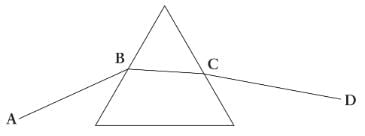MCAT Exam > MCAT Questions > Which phenomenon would cause monochromatic li...
Start Learning for Free
Which phenomenon would cause monochromatic light entering the prism along path AB to leave along path CD?


- a)Dispersion
- b)Refraction
- c)Diffraction
- d)Polarization
Correct answer is option 'B'. Can you explain this answer?
Verified Answer
Which phenomenon would cause monochromatic light entering the prism al...
Even though the light is traveling through a prism, the change in the light's direction is caused by refraction, not dispersion. Dispersion involves the breaking up of polychromatic light into its component wavelengths because the degree of refraction depends on the wavelength. We are told that the incident light is monochromatic or, in other words, of only one wavelength; therefore, light will not be dispersed, eliminating choice (A). Diffraction, choice (C), describes the spreading of light waves as they pass through a small opening. Polarization, choice (D), is the alignment of the electric field component of light waves.

|
Explore Courses for MCAT exam
|

|
Question Description
Which phenomenon would cause monochromatic light entering the prism along path AB to leave along path CD?a)Dispersionb)Refractionc)Diffractiond)PolarizationCorrect answer is option 'B'. Can you explain this answer? for MCAT 2025 is part of MCAT preparation. The Question and answers have been prepared according to the MCAT exam syllabus. Information about Which phenomenon would cause monochromatic light entering the prism along path AB to leave along path CD?a)Dispersionb)Refractionc)Diffractiond)PolarizationCorrect answer is option 'B'. Can you explain this answer? covers all topics & solutions for MCAT 2025 Exam. Find important definitions, questions, meanings, examples, exercises and tests below for Which phenomenon would cause monochromatic light entering the prism along path AB to leave along path CD?a)Dispersionb)Refractionc)Diffractiond)PolarizationCorrect answer is option 'B'. Can you explain this answer?.
Which phenomenon would cause monochromatic light entering the prism along path AB to leave along path CD?a)Dispersionb)Refractionc)Diffractiond)PolarizationCorrect answer is option 'B'. Can you explain this answer? for MCAT 2025 is part of MCAT preparation. The Question and answers have been prepared according to the MCAT exam syllabus. Information about Which phenomenon would cause monochromatic light entering the prism along path AB to leave along path CD?a)Dispersionb)Refractionc)Diffractiond)PolarizationCorrect answer is option 'B'. Can you explain this answer? covers all topics & solutions for MCAT 2025 Exam. Find important definitions, questions, meanings, examples, exercises and tests below for Which phenomenon would cause monochromatic light entering the prism along path AB to leave along path CD?a)Dispersionb)Refractionc)Diffractiond)PolarizationCorrect answer is option 'B'. Can you explain this answer?.
Solutions for Which phenomenon would cause monochromatic light entering the prism along path AB to leave along path CD?a)Dispersionb)Refractionc)Diffractiond)PolarizationCorrect answer is option 'B'. Can you explain this answer? in English & in Hindi are available as part of our courses for MCAT.
Download more important topics, notes, lectures and mock test series for MCAT Exam by signing up for free.
Here you can find the meaning of Which phenomenon would cause monochromatic light entering the prism along path AB to leave along path CD?a)Dispersionb)Refractionc)Diffractiond)PolarizationCorrect answer is option 'B'. Can you explain this answer? defined & explained in the simplest way possible. Besides giving the explanation of
Which phenomenon would cause monochromatic light entering the prism along path AB to leave along path CD?a)Dispersionb)Refractionc)Diffractiond)PolarizationCorrect answer is option 'B'. Can you explain this answer?, a detailed solution for Which phenomenon would cause monochromatic light entering the prism along path AB to leave along path CD?a)Dispersionb)Refractionc)Diffractiond)PolarizationCorrect answer is option 'B'. Can you explain this answer? has been provided alongside types of Which phenomenon would cause monochromatic light entering the prism along path AB to leave along path CD?a)Dispersionb)Refractionc)Diffractiond)PolarizationCorrect answer is option 'B'. Can you explain this answer? theory, EduRev gives you an
ample number of questions to practice Which phenomenon would cause monochromatic light entering the prism along path AB to leave along path CD?a)Dispersionb)Refractionc)Diffractiond)PolarizationCorrect answer is option 'B'. Can you explain this answer? tests, examples and also practice MCAT tests.

|
Explore Courses for MCAT exam
|

|
Signup for Free!
Signup to see your scores go up within 7 days! Learn & Practice with 1000+ FREE Notes, Videos & Tests.


















